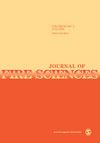矿井输送带防火分类
IF 1.9
4区 工程技术
Q2 ENGINEERING, MULTIDISCIPLINARY
引用次数: 4
摘要
本文提出了一个传送带火灾分类模型,该模型允许确定最有效的消防策略。此外,确定了皮带设计参数对火灾分级的影响。采用了一种涉及数值模拟和人工神经网络的方法。采用了先前提出的模拟传送带火灾的方法。为了获得一些所需的建模输入参数,并验证该方法获得真实结果的能力,利用文献中的实验测试结果对计算流体动力学模型进行了校准和验证。结果表明,巷道带位置越靠近顶板,巷道高度越高,直接攻击巷道需要的纵向风速越高。此外,人工神经网络提供的带火分类模型在测试场景分类时准确率在95%左右。本文章由计算机程序翻译,如有差异,请以英文原文为准。
Mine conveyor belt fire classification
This article presents a conveyor belt fire classification model that allows for the determination of the most effective firefighting strategy. In addition, the effect of belt design parameters on the fire classification was determined. A methodology that involves the use of numerical simulations and artificial neural networks was implemented. An approach previously proposed for modeling fires over conveyor belts was used. With the objective of obtaining some required modeling input parameter and verifying the capacity of this approach to get realistic results, computational fluid dynamics model calibration and validation were carried out using experimental test results available in the literature. Results indicated that scenarios with belt positions closer to the mine roof and greater tunnel heights require a higher longitudinal air velocity to be attacked directly. Furthermore, the belt fire classification model provided by the artificial neural network had an accuracy around 95% when test scenarios were classified.
求助全文
通过发布文献求助,成功后即可免费获取论文全文。
去求助
来源期刊

Journal of Fire Sciences
工程技术-材料科学:综合
CiteScore
4.00
自引率
0.00%
发文量
14
审稿时长
2.5 months
期刊介绍:
The Journal of Fire Sciences is a leading journal for the reporting of significant fundamental and applied research that brings understanding of fire chemistry and fire physics to fire safety. Its content is aimed toward the prevention and mitigation of the adverse effects of fires involving combustible materials, as well as development of new tools to better address fire safety needs. The Journal of Fire Sciences covers experimental or theoretical studies of fire initiation and growth, flame retardant chemistry, fire physics relative to material behavior, fire containment, fire threat to people and the environment and fire safety engineering. This journal is a member of the Committee on Publication Ethics (COPE).
 求助内容:
求助内容: 应助结果提醒方式:
应助结果提醒方式:


